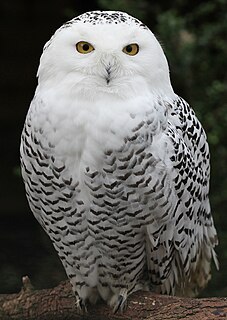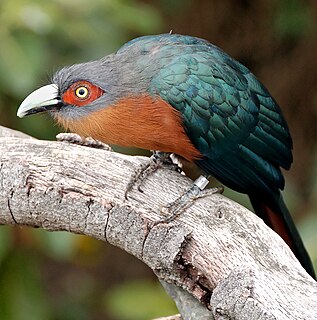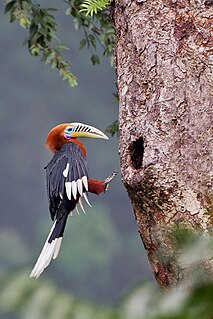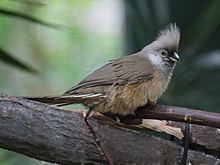
The Pelecaniformes are an order of medium-sized and large waterbirds found worldwide. As traditionally—but erroneously—defined, they encompass all birds that have feet with all four toes webbed. Hence, they were formerly also known by such names as totipalmates or steganopodes. Most have a bare throat patch, and the nostrils have evolved into dysfunctional slits, forcing them to breathe through their mouths. They also have a pectinate nail on their longest toe. This is shaped like a comb and is used to brush out and separate their feathers. They feed on fish, squid, or similar marine life. Nesting is colonial, but individual birds are monogamous. The young are altricial, hatching from the egg helpless and naked in most. They lack a brood patch.

The mesites (Mesitornithidae) are a family of birds that are part of a clade (Columbimorphae) that include Columbiformes and Pterocliformes. They are smallish flightless or near flightless birds endemic to Madagascar. They are the only family with more than two species in which every species is threatened.

The Phaethontiformes are an order of birds. They contain one extant family, the tropicbirds (Phaethontidae), and one extinct family Prophaethontidae from the early Cenozoic. Several fossil genera have been described.

Aequornithes, or core water birds are defined as "the least inclusive clade containing Gaviidae and Phalacrocoracidae".

Strisores is a clade of birds that includes the living families and orders Caprimulgidae, Nyctibiidae (potoos), Steatornithidae (oilbirds), Podargidae (frogmouths), Apodiformes, as well as the Aegotheliformes (owlet-nightjars) whose distinctness was only recently realized. The Apodiformes and the Aegotheliformes form the Daedalornithes.

Afroaves is a clade of birds, consisting of the kingfishers and kin (Coraciiformes), woodpeckers and kin (Piciformes), hornbills and kin (Bucerotiformes), trogons (Trogoniformes), cuckoo roller (Leptosomiformes), mousebirds (Coliiformes), owls (Strigiformes), raptors (Accipitriformes) and New World vultures (Cathartiformes). The most basal clades are predatory, suggesting the last common ancestor of Afroaves was also a predatory bird.

Telluraves is a recently defined clade of birds defined by their arboreality. Based on most recent genetic studies, the clade unites a variety of bird groups, including the australavians as well as the afroavians. They appear to be the sister group of a newly defined clade centered on Aequornithes.

Columbea is a clade suggested by genome analysis that contains Columbiformes, Pteroclidae (sandgrouse), Mesitornithidae (mesites) and Mirandornithes. Until their recent placement as the sister taxon to Passerea, in the last decade various genetic analysis found them to be in clade Metaves.

Passerea is a clade of neoavian birds that was proposed by Jarvis et al. (2014). Their genomic analysis recovered two major clades within Neoaves, Passerea and Columbea, and concluded that both clades appear to have many ecologically driven convergent traits.

Eurypygimorphae or Phaethontimorphae is a clade of birds that contains the orders Phaethontiformes (tropicbirds) and Eurypygiformes recovered by genome analysis. The relationship was first identified in 2013 based on their nuclear genes. Historically these birds were placed at different parts of the tree, with tropicbirds in Pelecaniformes and the kagu and sunbittern in Gruiformes. Some genetic analyses have placed the eurypygimorph taxa in the controversial and obsolete clade Metaves, with uncertain placement within that group. More recent molecular studies support their grouping together in Eurypygimorphae, which is usually recovered as the sister taxon to Aequornithes within Ardeae.

The Otidimorphae is a clade of birds that contains the orders Cuculiformes (cuckoos), Musophagiformes (turacos), and Otidiformes (bustards) identified in 2014 by genome analysis. While the bustards seem to be related to the turacos, other genetic studies have found the cuckoos to be closer to the bustards than the turacos are.

Eucavitaves is a clade that contains the order Trogoniformes (trogons) and the clade Picocoraciae. The name refers to the fact that the majority of them nest in cavities.

Accipitrimorphae is a clade of birds of prey that include the orders Cathartiformes and Accipitriformes. However, this group might be a junior synonym of Accipitriformes. The DNA-based proposal and the NACC and IOC classifications include the New World vultures in the Accipitriformes, but the SACC classifies the New World vultures as a separate order, the Cathartiformes which has been adopted here. The placement of the New World vultures has been unclear since the early 1990s. The reason for this is the controversial systematic history of the New World vultures as they were assumed to be more related to Ciconiidae after Sibley and Ahlquist work on their DNA-DNA hybridization studies conducted in the late 1970s and throughout the 1980s. The stork-vulture relationship has seemed to not be supported. Regardless of whether to use Accipitrimorphae or Accipitriformes, these birds belong to the clade Telluraves.

Cavitaves is a clade that contain the order Leptosomiformes and the clade Eucavitaves. The name refers to the fact that the majority of them nest in cavities.

Picocoraciae is a clade that contains the order Bucerotiformes and the clade Picodynastornithes supported by various genetic analysis and morphological studies. While these studies supported a sister grouping of Coraciiformes and Piciformes, a large scale, sparse supermatrix has suggested alternative sister relationship between Bucerotiformes and Piciformes instead.

Columbimorphae is a clade discovered by genome analysis that includes birds of the orders Columbiformes, Pterocliformes (sandgrouse), and Mesitornithiformes (mesites). Previous analyses had also recovered this grouping, although the exact relationships differed. Some studies indicated a sister relationship between sandgrouse and pigeons while other studies favored a sister grouping of mesites and sandgrouse instead.

Picodynastornithes is a clade that contains the orders Coraciiformes and Piciformes. This grouping also has current and historical support from molecular and morphological studies.

Columbaves is a clade that contains Columbimorphae and Otidimorphae discovered by genomic analysis by Prum et al. (2015). This conflicts with the Columbea and Otidae hypotheses which Mirandornithes are the sister taxon to Columbimorphae and Cypselomorphae the sister taxon to Otidimorphae, respectively, found by Jarvis et al. (2014). Neither hypothesis supports the two subdivisions of Metaves and Coronoaves as previous studies had found.

Aequorlitornithes is a clade of waterbirds recovered in a comprehensive genomic systematic study using nearly 200 species in 2015. It contains the clades Charadriiformes, Mirandornithes and Ardeae. Previous studies have found different placement for the clades in the tree.

Ardei is a suborder of order Pelecaniformes that include the families Ardeidae and Threskiornithidae. Traditionally the ardeids and threskiornithids were classified in the order Ciconiiformes along with Ciconiidae (storks), Phoenicopteridae (flamingos), Scopidae (hamerkop), Balaenicipitidae (shoebill), and even Cathartidae. However there were some osteological studies that have questioned the monophyly of Ciconiiformes, suggesting that the ardeids and threskiornithids originated from early gruiforms, with the latter being a transitionary taxon to order Charadriiformes. The polyphyly nature of Ciconiiformes is supported by recent genomic studies that have found support threskiornithids, ardeids, scopids and balaenicipitids being closely related to Pelecanidae (pelicans).




















